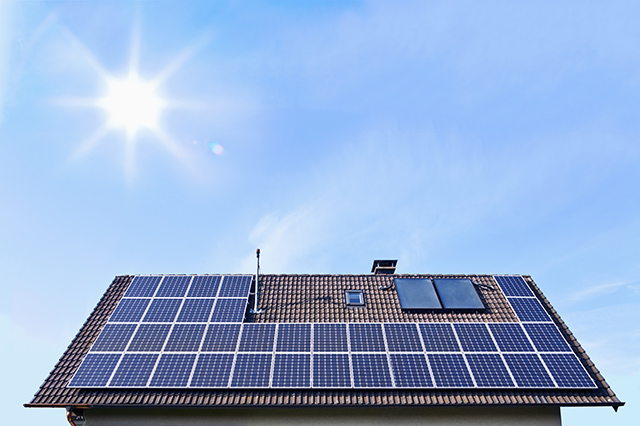The Northeast has fewer sunny days than other parts of the country, but the region is a solar leader. In fact, one out of every eight solar homes in the country is located in the Northeast, according to data from the US Energy Information Administration. For a number of reasons, the solar industry is booming in the Northeast.
Solar by State
According to data from the Solar Energy Industries Association, as of the summer of 2019, two Northeast states reached the top 10 nationwide for all-time solar installations: Massachusetts and New York. Not only do these two states lead the region in the amount of solar installed, they also lead the region in the number of solar-powered homes.
More than a quarter million homeowners have installed solar in the Northeast, with about 45% of those homes in New York and nearly 35% in Massachusetts. Given that the US recently surpassed 2 million homes with solar, Northeast states account for more than 12% of all solar installations in the US. Based on solar pricing data from EnergySage, homeowners in the Northeast have invested over $5 billion in residential solar alone.
| State | Total solar installed (megawatts) | National
State Rank | % of electricity from solar
(July 2019) | # of homes with solar
(2018) |
| CT | 606 | 20 | 2% | 34,500 |
| MA | 2,567 | 8 | 16% | 83,400 |
| ME | 60 | 42 | 1% | 4,000 |
| NH | 95 | 38 | 1% | 7,600 |
| NY | 1,775 | 9 | 2% | 107,000 |
| RI | 175 | 31 | 3% | 2,600 |
| VT | 304 | 25 | 18% | 7,700 |
Sources: US EIA Form 861 data, US EIA Electric Power Monthly, SEIA state data explorer
Another way to compare the success of solar state-by-state is to look at the percentage of a state’s electricity that is generated by solar. For instance, while New York reaches the top 10 for most solar installed nationwide, Rhode Island has far less solar installed but meets a higher percentage of the state’s electricity needs with solar.
Solar Incentives and Rebates in the Northeast
At present, the best solar incentive available anywhere in the country is the federal investment tax credit. The robust incentive, which has contributed significantly to the growth of the solar industry nationwide, saves the average solar shopper between $5,000 and $10,000 when they invest in solar. If you install solar in 2020, you’ll receive a credit on your taxes equal to 26% of your solar investment.
Beyond this nationwide solar incentive, many Northeast states provide their own additional solar incentives and rebates. For one, every state in the Northeast currently allows for net metering, which allows you to sell your solar electricity to the grid when you’re not using it and to purchase electricity from the grid when you need it and your panels aren’t producing. Importantly, net metering may not last forever in the Northeast: Connecticut’s net metering program may only last another two years, while Maine has already nixed, and then brought back, their net metering policy.
| State | Does the state allow net metering? | Any upfront rebates or tax credits for solar? | Any additional payments for the solar produced by your panels? | Any additional incentives for solar + storage systems? |
| CT | Yes | $0.463/W rebate | – | – |
| MA | Yes | Up to $1,000 tax credit | SMART Program | Utility-specific + SMART Program |
| ME | Yes | – | – | – |
| NH | Yes | Up to $1,000 rebate | – | Utility-specific |
| NY | Yes | Up to $0.35/W rebate
Up to $5,000 tax credit | – | State-run |
| RI | Yes | Up to $0.90/W rebate | OR $.28/kWh incentive | Utility-specific |
| VT | Yes | – | – | Utility-specific |
Individual states also offer an up-front rebate or a tax credit based upon the price of a solar installation. A rebate, like New Hampshire’s, will reduce the upfront cost of installing solar, similar to a rebate on any other home appliance. Alternatively, with a tax credit, like Massachusetts’, you will receive a credit on your taxes the following year. New York is the only Northeast state to offer both, significantly improving the finances of going solar in the state.
Additionally, a couple of states offer solar performance incentives, like the SMART program in Massachusetts or the optional Renewable Energy Growth program in Rhode Island. These solar programs pay for every unit of energy produced by your solar panels.
Finally, most states in the Northeast now also offer rebates or incentives for adding energy storage to a solar installation. Adding a battery to a solar panel system is becoming increasingly popular, as it allows you to continue to power your home with clean energy in the event of a power outage. These innovative policies and programs, including Green Mountain Power’s highly successful programs in Vermont, are making it more financially feasible to add storage to a solar installation.
The Future of Solar in the Northeast
Many states and utilities throughout the country have recently introduced 100% renewable energy targets, and Northeast states are no different. From 100% commitments from New York, Maine and Green Mountain Power, to a recent Connecticut announcement to study and pursue a clean energy future, the Northeast will need to continue to invest in the solar industry for decades to come.
In fact, two recent analyses describe just how much growth can be expected for solar in the region: Vote Solar found that increasing solar adoption to meet just Massachusetts’s energy goals would result in adding 8,000-9,000 local jobs, while the Brattle Group found that the Northeast could increase solar from 6 gigawatts (million kilowatts) currently to 107 gigawatts by 2050, in order to meet state climate goals.
And with solar energy systems paying for themselves very quickly in most Northeastern states, it’s no wonder why solar has taken off in the region. If you’re interested in learning about how much solar can save you, there are a number of free, online tools and resources to use, such as EnergySage’s Solar Calculator.
Learn more about if solar is right for you and your home. Before you go solar, talk to an insurance agent to see how you’ll be covered.
2 Thoughts on “Going Solar in the Northeast”
Leave A Comment
Comments are subject to moderation and may or may not be published at the editor’s discretion. Only comments that are relevant to the article and add value to the Your AAA community will be considered. Comments may be edited for clarity and length.
















A residential solar system will need battery storage if you want to be an offgrid not rely on the grid power. here the 15kwh system normally for a home user as a solar system backup
https://www.egbatt.com/product/15-kwh-48v-300ah-lithium-lifepo4-home-solar-battery-storage-system/
Thanks for the information. When the winter knocks on the door, then one can have this instead of a water heater.